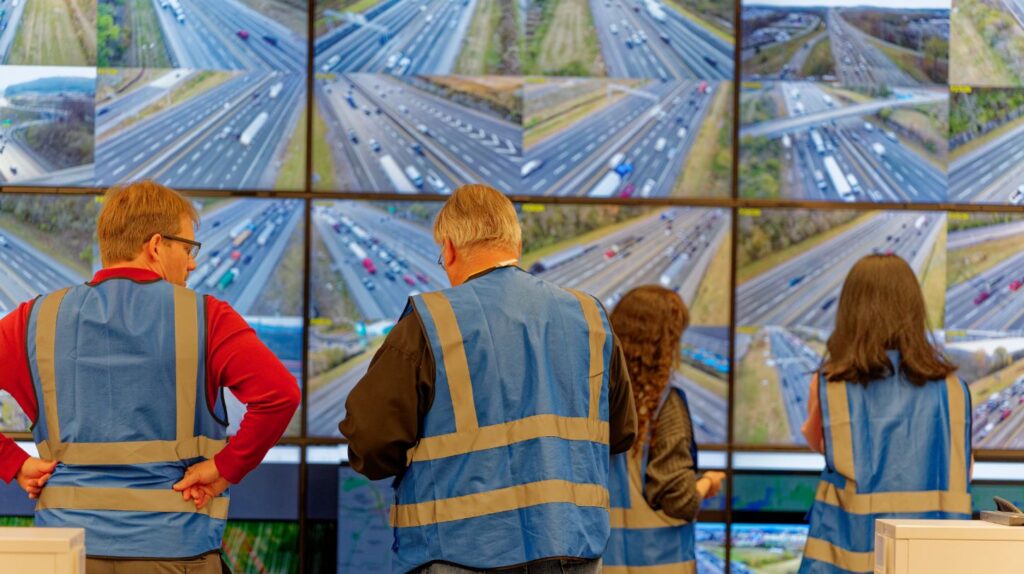Less than a year ago, civil engineers and computer scientists Dr Daniel Work and Professor Jonathan Sprinkle conducted what’s claimed to be the world’s largest real-world road test to study traffic dynamics and the role of connected and semi-autonomous vehicles in improving road efficiency and safety.
Located on a six-mile stretch of Interstate 24 in Tennessee, the groundbreaking I-24 MOTION (Multimodal Traffic Operations and I-24 Connected and Automated Vehicle Testbed) project, led by Vanderbilt University in collaboration with the Tennessee Department of Transportation (TDOT), aims to address traffic congestion, emissions, and accidents through the integration of advanced vehicle technology.
Equipped with more than 300 ultra-high-definition (4K) cameras mounted on 110ft (33.5m) poles, the testbed continuously monitors vehicle movements, capturing real-time data about every vehicle’s behaviour. This detailed, anonymous data is processed using artificial intelligence (AI) and trajectory algorithms to generate a precise digital model of traffic flow, allowing researchers to analyse vehicle interactions and pinpoint how connected and autonomous systems influence congestion.
By enabling vehicles to communicate with each other and the infrastructure, the I-24 MOTION project aims to minimise stop-and-go driving, ease traffic bottlenecks, and reduce energy consumption. The long-term goal is to foster a more sustainable and less stressful driving experience through advanced vehicle-infrastructure communication and optimised traffic management strategies.
The testbed not only studies the current effects of connected vehicles on real-world traffic but also provides a platform for testing future automated and traffic management technologies. The data collected can be used to inform the design of smarter roads, more efficient traffic management systems, and contribute to reduced fuel consumption, improved air quality, and overall enhanced road safety. Through the research, Vanderbilt University and TDOT hope to pave the way for sustainable urban mobility and smarter highways that benefit drivers, the environment, and infrastructure managers alike.
During a recent visit to the UK, Professor Sprinkle sat down with CiTTi Magazine to discuss the I-MOTION project and the technology’s potential future applications in Tennessee and beyond…
What is the background of the I-24 MOTION project and how was the system integrated into Tennessee’s traffic management system?
The I-24 MOTION project is led by my colleague Dr Daniel Work, and I’m fortunate to be a partner in it. Dan manages the intelligent integration of all the cameras, and the I-24 MOTION system itself is owned and operated by the Tennessee Department of Transportation (TDOT). With the help of a significant grant from the US Department of Transportation, we were able to install 40 poles, each standing 30-35m high, with six to 12 high-definition cameras on each pole. These cameras monitor the movement of cars without capturing personal details, such as the people inside or the number plates. It’s purely a scientific tool designed to track how fast vehicles are moving and where they are.
Through this process, I became involved in a research experiment focused on “traffic wave smoothing” on I-24, deploying self-driving cars that make small adjustments to their speed. These speed adjustments help reduce overall energy use on the road, benefiting not just the controlled cars but also those travelling behind, resulting in fuel savings and potentially improving safety.
Does the I-24 MOTION project use ANPR cameras?
Those systems aren’t used in Tennessee. While I’m not entirely sure, they might even be illegal in the state. Regardless, the purpose of this project is not to enforce speed limits or track individual vehicles. I know that in some UK congestion zones, number plate readers are used to charge vehicles moving through the area, but our project is focused on understanding traffic patterns and how traffic dynamics change as more vehicles enter the road.

During testing, 100 vehicles were introduced into the Tennessee road network to measure the system’s viability, showing a demonstrable reduction in traffic congestion. How many vehicles would be needed to further reduce congestion?
When looking at the charts, you see green zones, red zones, then green again. One of our goals is to turn everything yellow or orange, so drivers maintain an average speed. It remains a research question whether one in 20 cars, one in 10 cars, or five in eight vehicles are needed to achieve this. Some of our ongoing research focuses on understanding how one vehicle’s behaviour influences the drivers behind it. For example, if someone in the next lane also adopts a different driving style, how does that affect everyone else? We call this ‘effective compliance’. Eventually, when enough drivers maintain the same speed, it becomes difficult to pass, so most vehicles would maintain an average speed, resulting in more fuel-efficient and safer journeys.
Do you think a higher proportion of semi-autonomous vehicles, such as seven out of 10, would be necessary for the system to function effectively in a dense city environment, where frequent stops are more likely?
I believe the model changes when you introduce infrastructure like roundabouts, stop signs, and traffic signals, which naturally alter how traffic behaves. This is where collaboration between infrastructure control and vehicle behaviour becomes essential. For example, in a city with a bus network, signals may prioritise buses, allowing them to pass while other traffic waits. While this incentivises bus use, it may negatively affect overall traffic flow. Balancing these priorities to optimise traffic flow is one of the key research questions we’re interested in exploring.
The test showed significant fuel savings. As the number of cars using this system increases, do you think the fuel savings would scale accordingly?
In the initial open experiment with full-sized vehicles, we observed a 40% fuel saving compared to stop-and-go traffic. In stop-and-go situations, drivers tend to accelerate aggressively to close gaps, but on open roads, this reduction might not be as high – perhaps lower than 40%. However, as more vehicles join the system, the likelihood of stop-and-go waves decreases, as more vehicles will be driving at an average speed.
With more electric vehicles on the road, the 40% fuel saving might decrease, as these cars recuperate energy when braking and reuse it when accelerating. However, since internal combustion engines are still prevalent, we aim to help them save fuel too. Moreover, reducing the emissions of nitrous oxides and other pollutants from aggressive acceleration is crucial. The environmental benefits go far beyond just fuel savings.
Are there plans to test the system in different road network environments?
This project is fundamentally about understanding how traffic moves. One of the exciting outcomes of the 100-car test was that, on each day we ran it, we could capture how all the vehicles moved over a four-hour period. This allowed us to assess whether our vehicles had an impact. One of the immediate observations was that traffic waves formed regularly. For example, if they started 0.2 miles behind me, at 2.4 miles behind, those vehicles would encounter the same traffic wave. It’s the same traffic wave travelling through the system.
Some of the truly fascinating insights that have emerged from this involve understanding how traffic patterns have changed. The collaboration between the state institution, TDOT, and Vanderbilt as a research institution has enabled us to develop a broader understanding of traffic dynamics in general.
What key technological advancements or regulations would need to be implemented in other states or countries for this system to be applicable?
A particularly interesting aspect is how predictable traffic waves are when they start to form, and how that predictability could be used as a tool to mitigate congestion or improve safety. For example, if I know that a traffic stoppage is moving towards me, not just because I’m driving into it, but because it’s travelling in my direction, that could influence how my vehicle perceives it as a potential safety hazard. If I know that around a curve there’s likely to be stopped traffic, it changes how vehicles could respond to improve safety outcomes for all drivers, without needing extensive smart highway infrastructure. Vehicle-to-infrastructure (V2I) communication could transmit these signals to our cars, creating safer driving conditions.

Achievements and innovations intelligent transport systems will be celebrated at the third annual CiTTi Awards, which will be held on 26 November 2024 at De Vere Grand Connaught Rooms in London. Visit www.cittiawards.co.uk to learn more about this unmissable event for the UK’s transportation sector – and to book your table!




